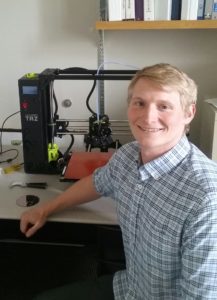Photo: Demonstration of a timber sample being collected and transported via water droplets on a microfluidic device.
Transnational environmental crime has become an exponential driver of species extinction, disrupting natural communities, and depleting innumerable species. Increasing demand for wildlife and wildlife products from emerging economies has attracted transnational criminal networks, making wildlife trafficking the fourth largest illicit economy in the world.
As wildlife and timber trafficking has become more organized, more lucrative and more technologically advanced, traffickers have developed new strategies to avoid detection. This arms race has left the officials responsible for stemming the tide increasingly overwhelmed. Customs officials need new technologies that provide enduring advantages over traffickers.

UW Bioengineering Ph.D. student Hal Holmes
Bioengineering Ph.D. student Hal Holmes is developing a device that could help customs officials and agents of conservation combat wildlife and timber trafficking. Hal aims to create a field-deployable screening tool that can determine if a product was sourced from an endangered or protected species by looking at the information encoded in its DNA.
From the Clean Room to Conservation
Hal is advised by Karl Böhringer, a joint UW professor of electrical engineering and bioengineering, and conducts research at UW’s Washington Nanofabrication Facility, where Dr. Böhringer serves as director. He is primarily interested in developing micro- and nanosystems for use in biological and environmental conservation applications. The systems could be adapted for other situations where identification of a species is required, such as validating seafood products in a restaurant, identifying contaminated or spoiled products, or verifying crops.
Hal has developed a microfluidic device that can test a sample, such as sawdust from timber, by using miniature water droplets as a vehicle to transport the sample and perform reactions. He has presented this work at the IEEE MEMS and microMAST conferences, filed for a full patent, and currently has a manuscript under review in Advances in Colloid and Interface Science.
Hal’s work brought him into contact with Conservation X Labs, a non-profit conservation technology accelerator. Conservation X Labs was starting a project to develop a DNA scanner or barcoder for species identification. The goal of this project is to enable a field-ready device that could provide a qualitative identification of a target species, serving as a decision support tool for enforcement officials rather than a device with medical-grade accuracy. Hal was invited to a DNA barcoding convention, hosted by Conservation X Labs at the Smithsonian Institution, for his expertise in engineering and microfabrication. After the convention, Hal began working closely with David Baisch, Director of Innovations at Conservation X Labs, applying his technology and expertise to enable the envisioned device.
Hal has recently presented his work with David at a Timber Identification Workshop hosted by the World Wildlife Fund and World Research Institute, and will be rolling out an initial prototype for field-testing with officers in the Washington Department of Fish and Wildlife this fall. After completing his Ph.D., Hal plans to pursue a path in academia and intends to continue collaborating with Conservation X Labs throughout his career.


